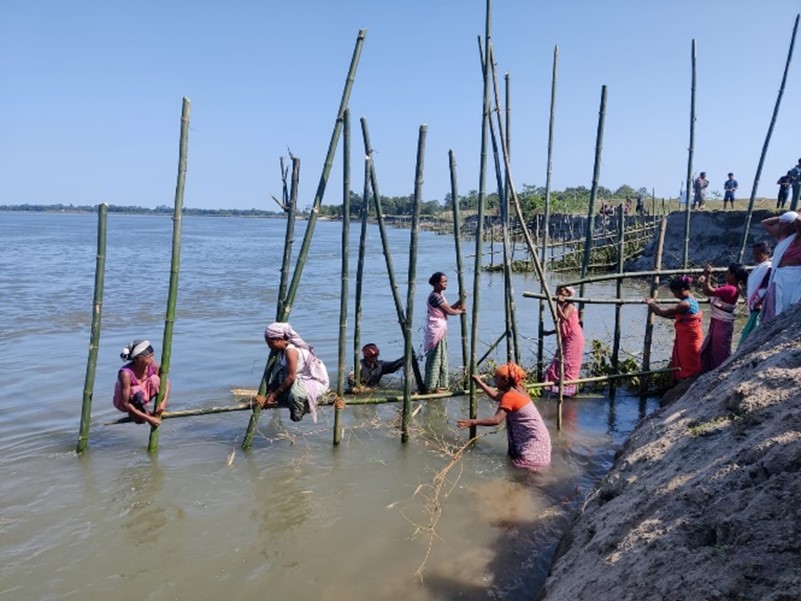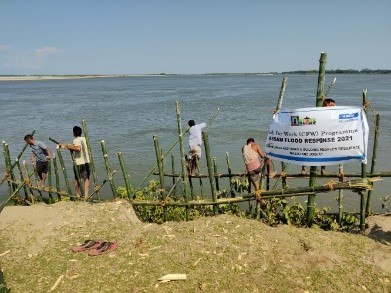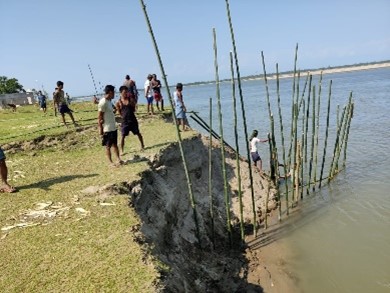Bamboo Porcupines

A Community-Based Innovation for River Bank Erosion Prevention in Flood-Affected Communities of Assam


Introduction
In the flood-prone regions of Assam in North-East India, the recurring challenge of river bank erosion poses a significant risk to communities, leading to loss of land, shelters, and livelihoods. To mitigate this issue, innovative community-driven practices such as the use of Bamboo Porcupines have emerged as sustainable and effective solutions to protect riverbanks and empower vulnerable communities.
Initiative of North-East Affected Area Development Society (NEADS)
NEADS, a member of India Humanitarian Hub (IHH) has been upscaling this innovative solution to combat river bank erosion. This community-driven innovation involves strategically placing bundles of bamboo along vulnerable river banks to reinforce stability and prevent erosion during annual floods. By connecting local resources and knowledge, the organisation has been empowering communities to take proactive measures in safeguarding their habitats. This initiative not only addresses immediate threats posed by river bank erosion but also promote sustainable solutions rooted in resilience and community collaboration.
Background
The state Assam, which is characterized by its complex network of rivers, is prone to severe river bank erosion during the monsoon season. The Brahmaputra River and its key tributaries often breach their banks, causing widespread devastation to communities living along the riverfront. River bank erosion leads to displacement, loss of agricultural land, and increased vulnerability for those already grappling with the challenges of annual flooding.
Community-Based Good Practices
The concept of Bamboo Porcupines involves the strategic use of bamboo structures along riverbanks to scatter the energy of flowing water, thereby reducing erosion and protecting the integrity of the riverbank. This community-driven initiative leverages local materials and traditional knowledge to create an environmentally friendly and sustainable solution to the persistent problem of river bank erosion in Assam.
The Key Components:
- Bamboo Construction: Bamboo, abundantly available in the region, is a multipurpose and resilient material. Communities construct porcupine-like structures using bamboo stakes driven into the riverbank at an angle, creating a natural barrier against the force of the water.
- Indigenous Knowledge: The construction and installation of Bamboo Porcupines are carried out by local community members who possess traditional knowledge and skills. This ensures that the structures are adapted to the specific needs and characteristics of the riverbank, maximizing their effectiveness.
- Flexibility and Adaptability: Bamboo Porcupines can be easily adjusted and modified to suit different sections of the riverbank or varying water levels. This flexibility allows communities to adapt the structures based on seasonal changes and specific river dynamics.
- Eco-Friendly Approach: By relying on bamboo, an eco-friendly and renewable resource, Bamboo Porcupines contribute to sustainable environmental practices. They blend seamlessly with the natural surroundings, minimizing the ecological impact while addressing the erosion issue.
Benefits of Bamboo Porcupines:
- Erosion Mitigation: The primary purpose of Bamboo Porcupines is to mitigate river bank erosion by scattering the energy of flowing water, preventing it from eroding the soil and destabilizing the riverbank.
- Cost-Effectiveness: Bamboo is a cost-effective material that is readily available in the region. The use of local resources ensures that the construction of Bamboo Porcupines is affordable and sustainable for the communities.
- Community Empowerment: Involving local community members in the construction and maintenance of Bamboo Porcupines not only empowers them with skills but also build a sense of ownership and responsibility for the protection of their land and homes.

Conclusion
Bamboo Porcupines exemplify the power of community-based innovation in addressing the complex challenges posed by river bank erosion in flood-prone regions like Assam. By combining traditional knowledge with locally available materials, these structures not only provide an effective solution to the immediate problem but also empower communities to actively participate in the protection and preservation of their land. As climate change continues to impact vulnerable regions, initiatives like Bamboo Porcupines showcase the importance of sustainable, community-driven practices for a more resilient and adaptive future.
